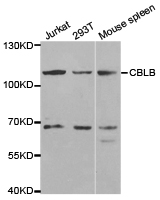CBLB Rabbit Polyclonal Antibody
Frequently bought together (3)
Recombinant protein of human Cas-Br-M (murine) ecotropic retroviral transforming sequence b (CBLB)
USD 823.00
Transient overexpression lysate of Cas-Br-M (murine) ecotropic retroviral transforming sequence b (CBLB)
USD 436.00
Other products for "CBLB"
Specifications
| Product Data | |
| Applications | ELISA, WB |
| Recommended Dilution | WB,1:500 - 1:1000 ELISA,Recommended starting concentration is 1 μg/mL. Please optimize the concentration based on your specific assay requirements. |
| Reactivities | Human, Mouse, Rat |
| Host | Rabbit |
| Isotype | IgG |
| Clonality | Polyclonal |
| Formulation | Buffer: PBS with 0.02% sodium azide,50% glycerol,pH7.3. |
| Concentration | lot specific |
| Purification | Affinity purification |
| Conjugation | Unconjugated |
| Storage | Store at -20℃. Avoid freeze / thaw cycles. |
| Stability | Stable for 12 months from date of receipt. |
| Predicted Protein Size | 109kDa |
| Gene Name | Cbl proto-oncogene B |
| Database Link | |
| Background | This gene encodes an E3 ubiquitin-protein ligase which promotes proteosome-mediated protein degradation by transferring ubiquitin from an E2 ubiquitin-conjugating enzyme to a substrate. The encoded protein is involved in the regulation of immune response by limiting T-cell receptor, B-cell receptor, and high affinity immunoglobulin epsilon receptor activation. Studies in mouse suggest that this gene is involved in antifungal host defense and that its inhibition leads to increased fungal killing. Manipulation of this gene may be beneficial in implementing immunotherapies for a variety of conditions, including cancer, autoimmune diseases, allergies, and infections. |
| Synonyms | Cbl-b; Nbla00127; RNF56 |
| Reference Data | |
| Protein Families | Druggable Genome |
| Protein Pathways | Chronic myeloid leukemia, Endocytosis, ErbB signaling pathway, Insulin signaling pathway, Jak-STAT signaling pathway, Pathways in cancer, T cell receptor signaling pathway, Ubiquitin mediated proteolysis |
Documents
| Product Manuals |
| FAQs |
| SDS |
{0} Product Review(s)
0 Product Review(s)
Submit review
Be the first one to submit a review
Product Citations
*Delivery time may vary from web posted schedule. Occasional delays may occur due to unforeseen
complexities in the preparation of your product. International customers may expect an additional 1-2 weeks
in shipping.






























































































































































































































































 Germany
Germany
 Japan
Japan
 United Kingdom
United Kingdom
 China
China



